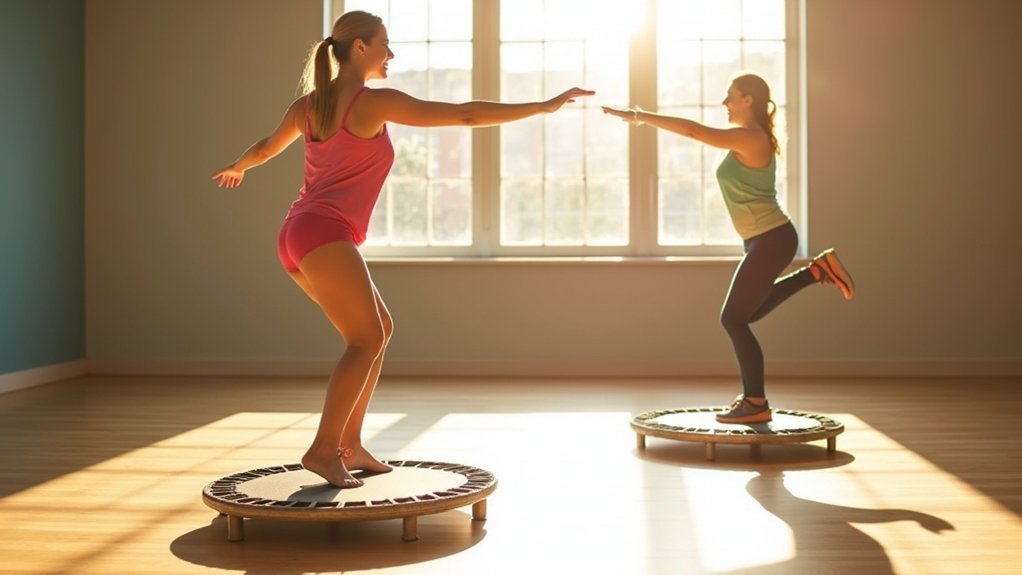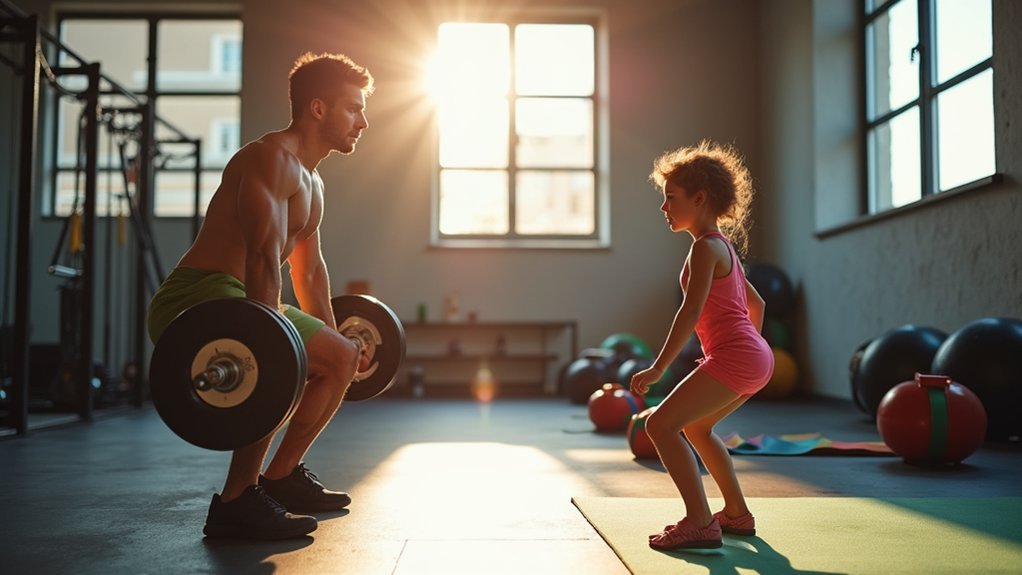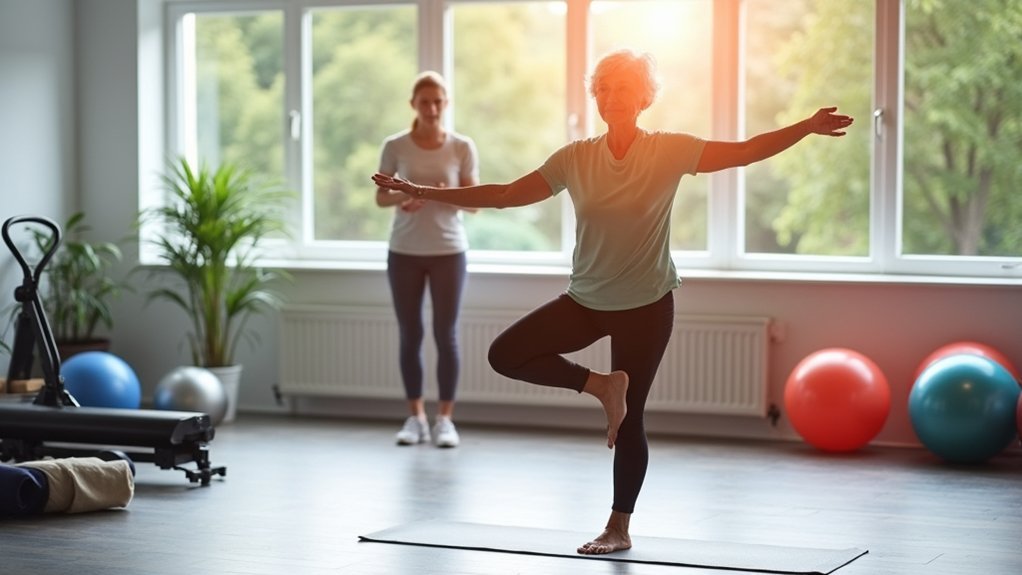Both weighted movements and mini-exercises strengthen bones, but they work differently. Weighted exercises like resistance training create focused stress that triggers bone remodeling, while mini-exercises provide repetitive impact throughout the day. For ideal results, combine both approaches 2-3 times weekly, gradually increasing intensity. Start with low-impact options if you’re older or have bone concerns. The right mix of these techniques will help you build a solid foundation for lifelong skeletal health.
Understanding How Different Exercises Affect Bone Density

When it comes to maintaining healthy bones, not all exercises deliver the same benefits. Your skeleton responds differently to various forms of stress, which directly impacts bone density.
Weighted movements like resistance training with dumbbells create significant bone-strengthening forces, particularly in vulnerable areas like your spine and hips. These exercises stimulate bone remodeling, a process essential for preventing osteoporosis.
Meanwhile, mini-exercises such as brief walking sessions or jumping intervals provide repetitive impact that also enhances bone health, though typically with less intensity. Higher-impact activities generally yield greater benefits than lower-impact alternatives.
For ideal bone density, you’ll want to combine both approaches—incorporating weighted movements for targeted strength and mini-exercises for overall skeletal stimulation. A consistent routine performed 2-3 times weekly provides the progressive overload your bones need to stay strong.
The Science Behind Impact Loading and Bone Strength
Although many people focus on muscles during exercise, your skeleton actually responds dramatically to physical forces through a fascinating process called impact loading. This phenomenon, governed by Wolff’s Law, means your bones adapt to mechanical stress by becoming stronger and denser.
When you engage in weight-bearing exercises like jumping, running, or hopping, you’re creating beneficial stress on your skeletal system. Research shows high-impact activities stimulate bone remodeling more effectively than low-impact alternatives, leading to greater improvements in bone density.
For maximum benefits, incorporate varied movements and directional changes into your routine. This approach engages multiple muscle groups while applying forces to different parts of your skeleton.
Your bones literally become stronger by responding to the demands you place on them through regular impact loading.
Rebounding: Low-Impact Benefits for Fragile Bones

When you bounce on a mini-trampoline, you’re protecting vulnerable joints while still applying the gentle force needed to stimulate bone cells.
Your rebounding movements create enough impact to trigger osteoblast activity without the harsh jarring that traditional weight-bearing exercises might cause.
You’ll notice that this cellular stimulation occurs throughout your entire skeletal system, making rebounding an efficient choice for those with osteoporosis or bone fragility concerns.
Gentle Joint Protection
Despite common concerns about exercise with fragile bones, rebounding offers a safe alternative that protects vulnerable joints while building strength.
If you’re managing osteoporosis or low bone density, mini-trampolines provide the weight-bearing exercise benefits your skeleton needs without harsh impact.
Your joints receive gentle protection through rebounding in three key ways:
- The trampoline surface absorbs up to 87% of impact force that would normally stress your ankles, knees, and hips.
- The gravitational loading during bouncing stimulates bone formation without jarring fragile areas.
- The controlled movement pattern strengthens stabilizing muscles around joints, creating natural protection.
You’ll find that this exercise approach allows consistent bone health improvement without risking the joint damage that can occur with higher-impact activities.
Cellular Bone Stimulation
At the cellular level, rebounding transforms bone health through unique biomechanical forces that conventional exercises can’t match. Your bones respond to the gentle gravitational changes during mini-trampoline exercises, stimulating osteoblast activity without the harsh impact of traditional weight training.
| Benefit | Rebounding | Traditional Weight Training |
|---|---|---|
| Impact Level | Low-impact, gentle | High-impact, potentially jarring |
| Bone Response | Gradual density increase | Targeted strengthening |
| Fall Prevention | Improves balance coordination | Limited balance training |
| Accessibility | Suitable for osteoporosis | May require modifications |
You’ll find rebounding particularly valuable if you’re concerned about fracture risk. The rhythmic bouncing motion challenges your equilibrium, enhancing balance while simultaneously delivering the weight-bearing stimulus your bone cells need to maintain and build strength—all without risking injury to compromised skeletal structures.
Resistance Training: Creating Targeted Bone Stress
Although bones might seem static, they’re actually living tissue that responds dynamically to stress. Resistance training provides the perfect stimulus to enhance bone strength by applying focused pressure that triggers remodeling.
When you work major muscle groups, especially those connected to your hips and spine, you’re directly combating osteoporosis risks.
For ideal bone-building results:
- Perform 8-12 different exercises targeting multiple muscle groups, 2-3 times weekly
- Complete 1-2 sets of 8-10 repetitions per exercise, gradually increasing the weight you lift
- Use proper technique with slow, controlled movements while engaging your core muscles
Remember to progressively challenge your bones with heavier resistance over time. This prevents plateaus and guarantees continuous improvement in bone density—crucial for maintaining skeletal integrity as you age.
Mini-Exercise Routines You Can Do Anywhere

While dedicated resistance training offers significant bone benefits, not everyone has the time or access to gym equipment every day. You can still support bone health through mini-exercises integrated into your daily activities. These brief movement sessions stimulate bones and build muscle strength without disrupting your schedule.
| Exercise Type | Time Needed | Bone Benefit |
|---|---|---|
| Calf raises | 2-3 minutes | Strengthens lower leg bones |
| Wall sits | 1-2 minutes | Builds femur density |
| Balance stands | 30-60 seconds | Improves stability |
| Mini squats | 1-2 minutes | Stimulates hip joints |
Weight-bearing activities like stair climbing and brief walking breaks provide valuable bone stimulation. Try performing these mini-exercises for 10-15 minutes several times daily—consistency matters more than duration. Standing on one leg while brushing teeth or doing push-ups against your desk transforms idle moments into bone-building opportunities.
Weighted Movements That Maximize Osteogenesis
The impact of weighted resistance training on bone health can’t be overstated. When you incorporate weighted movements into your exercise program, you’re actively stimulating osteogenesis—the process of new bone formation—which directly enhances bone density over time.
For peak benefit, focus on these key exercises:
- Compound lifts – Squats and deadlifts create mechanical stress that signals your bones to strengthen, particularly in the spine and hips.
- Multi-joint movements – Lunges and bench presses engage multiple muscle groups, improving overall bone strength through varied loading patterns.
- Progressive resistance training – Gradually increasing weights guarantees ideal bone stimulation without injury risk.
Aim for 2-3 resistance training sessions weekly, using proper technique to maximize osteogenic benefits.
Your bones will respond best to consistent, challenging weighted movements that safely push your limits.
Combining Approaches: Creating a Balanced Bone-Building Regimen
You’ll see ideal bone health improvements by alternating between impact exercises and resistance training throughout your week, rather than focusing exclusively on one approach.
Incorporating 5-10 minute movement mini-sessions into your daily routine creates consistent bone-building stimuli without overwhelming your schedule.
As your strength builds, gradually increase weight and resistance while maintaining proper form to guarantee your bones receive progressive loading—the key driver for continued density improvements.
Mix Impact and Resistance
Creating a truly effective bone-building regimen requires thoughtfully combining both impact and resistance exercises into your weekly routine. The synergy between weighted movements and impact exercises stimulates bone growth through varied stress levels, which is essential for preventing osteoporosis and maintaining overall bone health.
For ideal results, aim to:
- Schedule 2-3 weekly sessions alternating between high-impact activities (jogging, dancing) and resistance training (squats, lunges) to continuously challenge your skeletal system.
- Incorporate multi-joint movements across different planes of motion, such as step-ups and lateral lunges, to target multiple muscles while enhancing bone density.
- Implement interval training that combines brief periods of high-intensity impact with muscle-strengthening exercises to maximize bone-building benefits.
Remember to gradually increase intensity and diversify your exercises to avoid plateaus and sustain continuous improvements in muscle strength and bone density.
Daily Movement Mini-Sessions
Why limit bone-building efforts to structured workouts when your entire day offers opportunities for skeletal strength? Incorporating mini-exercises throughout your daily routine provides consistent bone health stimulation without demanding lengthy gym sessions.
Try short bursts of weight-bearing activities like brisk walking or stair climbing several times daily.
Enhance these moments by adding weighted movements—light dumbbells during lunges or resistance bands while standing in line can transform ordinary moments into bone-strengthening opportunities. These brief sessions simultaneously build muscle strength, which directly contributes to bone density as muscles pull on your skeletal framework.
For maximum protection against osteoporosis, include balance activities like standing on one foot while brushing your teeth. Aim for 30 minutes of these varied mini-exercises throughout your week, alternating between higher and lower impact options to keep your bones responsive.
Progressive Loading Strategy
While mini-exercises offer convenience, a strategic approach to bone strengthening combines both spontaneous activities and planned progressive loading. Your bones respond best to gradually increasing challenges that stimulate renewal and growth.
Create a balanced bone-building regimen by:
- Combining weighted movements (squats, lunges) with mini-exercises (balance drills) 2-3 days weekly for 20-30 minutes to effectively load bones and muscles.
- Incorporating both high-impact activities and low-impact resistance training to maximize bone strength while minimizing injury risk.
- Reassessing your exercise program every 2-3 months to verify you’re adequately challenging your skeletal system.
This combined approach guarantees you’re not just moving frequently but also progressively challenging your bones with sufficient resistance—the key factor in developing long-term bone strength and preventing density loss.
Measuring Progress: How to Track Bone Health Improvements
How do you know if your bone-strengthening regimen is actually working? Periodic bone density scans provide the most definitive measurement of your bone health, showing quantitative changes in bone mineral density over time.
Bone density scans offer concrete evidence of your regimen’s effectiveness, revealing the true story of your skeletal health.
But you needn’t wait for these tests to monitor progress. Keep a detailed exercise log tracking your strength training program, including weight increases and exercise modifications. This helps identify patterns in your exercise program for bone improvement.
Use wearable fitness trackers to guarantee you’re meeting the recommended 150 minutes of weekly activity. Additionally, monitor physical performance metrics like balance and coordination, which indicate progress and ability to prevent falls.
Regular consultations with healthcare providers offer professional guidance, especially if you have osteoporosis or osteopenia. They can help interpret your data and adjust your regimen accordingly.
Adapting Your Routine for Age and Bone Density Levels
As you age, your bone exercise strategy needs to evolve from simply “staying active” to targeted movements that maintain density where you need it most.
You’ll benefit from starting with mini-exercises like wall pushups or gentle squats if you have lower bone density, then progressively advancing to weighted movements as your strength improves.
Regular adjustments to your routine based on bone density test results will guarantee you’re challenging your skeletal system appropriately without risking injury.
Age-Targeted Bone Exercises
Your bone health needs evolve considerably with age, requiring thoughtful adaptation of exercise routines to match your changing physiology.
As bone density naturally declines, focus on weight-bearing exercises targeting vulnerable areas like hips and spine to combat osteoporosis.
For ideal bone strength, consider these age-targeted exercise approaches:
- Start with low-impact exercises like walking or swimming if you’re older or have reduced bone density, then gradually introduce moderate-impact activities like dancing.
- Incorporate mini-exercises such as single-leg stands or gentle squats to enhance balance and stability, reducing fall risks.
- Maintain consistency with at least 30 minutes of weight-bearing exercises most days, adjusting intensity based on your capabilities.
Always consult a healthcare professional before beginning any new bone-strengthening routine.
Progressive Density Training
Progressive Density Training takes bone health exercises to the next level by systematically increasing resistance over time. This approach is particularly valuable for preventing osteoporosis as you age, allowing your bones to continuously adapt and strengthen.
If you’re dealing with osteopenia or osteoporosis, start with lighter weights and gradually increase the load under professional guidance. Aim to perform resistance exercises targeting major muscle groups two to three times weekly, adjusting intensity based on your current bone density levels.
Your body’s response to increased weights will vary, so pay attention to how you feel during and after workouts.
Regular medical check-ups to monitor your bone density will help you fine-tune your training program. With consistent progressive density training, you’ll improve bone density while minimizing injury risk—creating a sustainable approach to skeletal strength.
Safety Considerations for Both Exercise Types
Three critical safety factors must be considered when choosing between weighted movements and mini-exercises for bone health.
Regardless of your exercise choice, prioritizing safety guarantees you’ll strengthen bones without risking injury.
1. Form matters most – When performing weighted movements, proper form prevents stress on vulnerable areas.
If you have osteoporosis, maintaining correct alignment is non-negotiable.
2. Know your limits – Choose low-impact activities if you have compromised bone health.
Mini-exercises like balance training provide benefits with minimal fall risk.
3. Avoid risky movements – Skip exercises involving twisting or excessive forward bending, especially with weights.
Instead, focus on strengthening hips and spine with controlled, comfortable movements.
Always consult a healthcare professional before starting any bone-strengthening routine, particularly if you have existing bone density concerns.
Frequently Asked Questions
What Type of Exercise Is Most Effective at Strengthening Bone?
Weight-bearing, high-impact exercises like running and jumping are most effective at strengthening your bones. You’ll get ideal results by combining these with resistance training at least 2-3 times weekly for 20-30 minutes.
Is Rebounder Good for Bone Density?
Yes, rebounding is beneficial for your bone density. When you bounce on a mini-trampoline, you’ll experience gentle weight-bearing forces that can stimulate bone growth while minimizing joint impact. It’s especially helpful for spine and leg bones.
What Is the Best Exercise Equipment for Bone Density?
The best exercise equipment for bone density includes weight-bearing tools like dumbbells, kettlebells, and resistance bands. You’ll benefit most from equipment that forces your muscles to work against gravity, strengthening your bones effectively.
What Is the Fastest Way to Increase Bone Density?
To increase bone density fastest, you’ll need high-impact weight-bearing exercises like jumping or running, combined with progressive resistance training 2-3 times weekly. Don’t forget to regularly increase intensity to avoid plateaus in improvement.
In Summary
Whether you’re lifting weights or jumping through mini-exercises, consistency is key for bone health. You’ll see best results by incorporating both approaches into your routine. Remember to adjust intensity based on your bone density, age, and fitness level. Don’t get discouraged—even small movements count! Track your progress, celebrate improvements, and you’ll build stronger bones that support you through every stage of life.




Leave a Reply